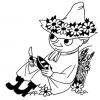I wanted to look closely at the 3rd movement over the others because Berg uses a very innovative method of rhythmic organisation that is used in a lot of later 20th century music.
3rd movement link:
The movement is a scherzo and trio. The outer scherzo sections are serial whilst the trio is composed freely and actually serves as a taster of the exposition of the following 4th movement. Rather than using exactly the same row that was used in the 1st movement, Berg takes the 1st movement row and swaps the positions of notes 3 and 9 to create what is known as a permutation of the original row.
1st movement row:
F E C A G D Ab Db Eb Gb Bb B
3rd movement permutation of row:
0 1 2 3 4 5 6 7 8 9 A B
F E C Gb G D Ab Db Eb A Bb B
In this movement, the row isn’t only important as a means of determining pitch; the rhythmic content of the movement is almost completely derived from the row. Firstly, Berg splits the row into two groups based upon their position within a single octave: The first group, <0-3-4-6-9-A-B>, includes all notes that lie below C, with the second group, <1-2-5-7-8>, including all notes that lie above B. Berg then takes the interval content of each of these two groups and uses the quantity of semitones between each note of the group to form a durational pattern. The group <0-3-4-6-9-A-B> has the interval content [no. of semitones between each note] (3-1-2-3-1-1-1). This durational pattern, with one quaver as the standard unit, first appears in the cello part in mm. 6-8. The pattern derived from the second group, (1-3-2-1-1) follows the first pattern immediately in mm. 8-9 (The durations of certain notes in the group are irrelevant; it is the timing of the attack of the notes that is important. 2 could be a crotchet or it could be a quaver followed by a quaver rest). The majority of rhythmic organisation in the 3rd movement can be attributed to these two rhythmic motives and their augmentations, diminutions and variations.
Some may ask: what is the point of deriving the rhythm directly from the row? It’s not like the ear can make such a complex connection between pitch and rhythm so the only merits of using such a technique would be academic and not musical. This is true to an extent and is one of the issues with the total serialism of the 1950s. A lot of composers seemed to be overly concerned with achieving unity between all aspects of the music with pitch, rhythm, dynamics, timbre, tempo, articulation, register and pretty much anything else being derived from a single tone row. However, in this case, the procedure results in 2 very easily identifiable and well defined rhythmic motives that always reappear in connection with a specific series of pitches. A comparable classical example of a similar connection between rhythmic motive and pitch would be Beethoven’s 5th symphony. The whole symphony, especially the 1st movement, is dominated by the combination of the 3 quavers followed by a longer note rhythmic motive with the descending major and minor 3rd melodic material. The constant recurrence of similar rhythm in combination with similar pitch content strengthens the overall effect of the motive. The premise with the Lyric Suite 3rd movement is the same and the combination helps mark the divide between the scherzo and trio sections.
I would like to skip talking about the trio section of the movement because it doesn’t really deal with anything that we haven’t already come across in the 1st and 3rd movement to this point. Instead, I’ll skip to the return of the scherzo which is a retrograde of the 1st scherzo section.
It is in the return of the scherzo that the significance of applying serial technique to rhythm becomes apparent. Berg doesn’t just simply write the notes out in reverse order as would normally happen in a traditional retrograde. Instead, Berg reverses the durational patterns used to create the original rhythmic motives, so (3-1-2-3-1-1-1) becomes (1-1-1-3-2-1-3), while (1-3-2-1-1) becomes (1-1-2-3-1). The consequence of this is that the retrograde mirrors the attack points of the original scherzo. Think of a sound that has been reversed; the attack of the sound now occurs at the end of it rather than at the beginning. If the sound was a crotchet in length and we truly reversed it, the attack would occur towards the end of the note, perhaps on the 2nd quaver. So, we might write a truly retrograded crotchet as a quaver rest followed by a quaver. This is achieved when a series is used to organise rhythm. The attack points are left intact to create a true retrograde that can be perceived by the ear rather than a retrograde that simply looks nice on paper.
Well that pretty much covers all of the major techniques used by Berg in the Lyric Suite. I'll put together another analysis soon, probably something from a bit later in the 20th century that isn't serial. Maybe some Messiaen or Ligeti or something else.


